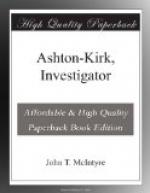“I would have pronounced him a musician, even if I had not heard that he was one,” said Ashton-Kirk. “The head and face formations have all the qualities.” Then he ran over the story of Spatola’s arrest and the causes that led up to it. At the finish he smiled. “They have tried and convicted him on the first page. If there was any way for them to do it, they’d execute him in the evening editions and print his dying words in the sporting extra. But,” and he nodded his head appreciatively, “Osborne has a good case against him, at that.”
Both the clerk, Isidore Brolatsky, and Berg seemed to have talked freely to the newspapermen. The character of Hume was treated in a highly colored manner. The visits of the Italian musician to the numismatist, his ambition to shine as another Kubelik, his ungovernable temper, the high words that followed Hume’s frequent sneers at his ambition and the fact that he once drew a knife upon his tormentor, were presented in full. But what appealed to the space-writers most was Brolatsky’s story of how Hume had once called Spatola “Mad Anthony,” and afterward showed him the portrait of General Wayne.
“This apparently drove him frantic,” wrote one reporter, “and, noting this, Hume frequently applied the name to him, and more than likely displayed the portrait as well. The last time that Spatola visited Hume was upon the night of the murder. He evidently went to regale the numismatist with music; for the delicatessen dealer, Berg, saw under his coat what was evidently his violin. During the course of the concert, Hume probably resumed his sneers; unable any longer to bear it, the Italian apparently struck him down, and then in blind rage of resentment, smashed and otherwise destroyed every one of the Wayne portraits he could find.”
Fuller came in with another newspaper just about this time and Ashton-Kirk showed him the story.
“The Standard, then, seems to ignore the theory held by Osborne and Stillman that the murder was done in an attempt to steal the portrait found partly cut from the frame,” said the assistant after studying the account. Then, inquiringly, he added: “What do you think of it, sir?”
“As a piece of sensational writing, I have no fault to find with it,” said the investigator. “But the Standard’s young man is no deep thinker. The single fact that Hume was a lover of real music should have shown him that his theory was wrong.”
Fuller considered a moment.
“I don’t think I quite get that,” said he.
“It is simple enough. Hume being sensitive to harmony, asked Spatola very frequently to play for him; and, according to Brolatsky, paid him rather well for each performance. To furnish good music, Spatola must have not only talent, but also a violin that was at least fairly good.”
“Yes, sir, I see that.”
“Having a violin that was at least fairly good, Spatola, being a poor man, would take care of it. He would carry it in a case—he would especially do so in wet or damp weather. And it rained on the night of the murder. If he carried his violin in a case, there was no need of his putting it under his coat. And, another thing, a violin case is of such size as to prevent its being so carried, isn’t it?”




